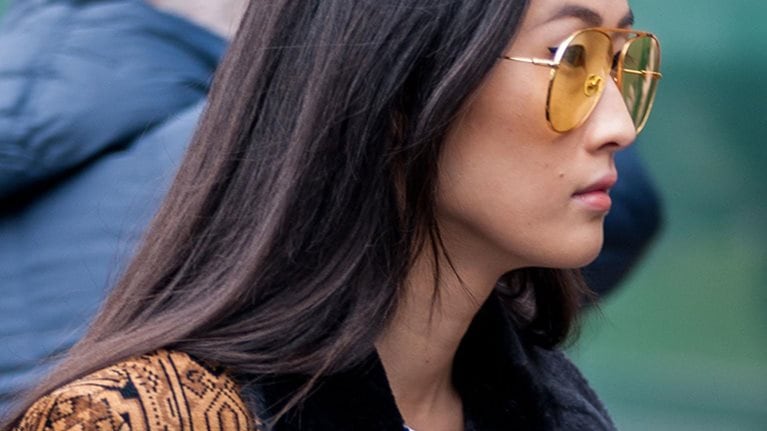The heady days when China briefly displaced the United Kingdom and the United States as the world’s leading art market may have been a blip, but Asia’s vibrant and still-young art market is demonstrating reassuringly stable growth.
Even as China’s economy encountered headwinds late last year, leading global auction house Christie’s closed a strong autumn season in the region, selling lots worth a combined $353 million, including Su Shi’s 1,000-year-old masterwork Wood and Rock for a touch under $60 million—making it the most expensive object ever sold by Christie’s in Asia.
Christie’s would only confirm that “a Chinese buyer” took home the rare ink painting, perhaps unsurprising, given that, despite a recent uptick in interest in Western artists, buyers in Hong Kong still strongly prefer art sourced from close to home.
The Art Basel and UBS global Art Market Report 2018 found that in 2017, China accounted for 21 percent of the $63 billion global art market, second only to the United States. The report also forecast Asia’s overall share of global sales to increase on the back of buoyant wealth dynamics.
Many of the pieces responsible for that growth will come “under the hammer” in Hong Kong, from where Rebecca Wei, chairman of Christie’s Asia, directs client management. In her previous role as president, she also oversaw auctions, private sales, and e-commerce across the region, among a host of other responsibilities.
Under her tenure, the contribution of Asian buyers to Christie’s global sales has risen to upward of 25 percent, spurring openings of new gallery spaces across Greater China, and the consolidation of the house’s entire Asia business, including the previously distinct China market, into its Hong Kong offices.
Having weathered a bout of fierce competition that spurred a tendency to lock in prices ahead of auctions to secure consignments, Wei now sees a more rational market emerging, and with it, the room to grow her existing Asia team of more than 200 staff.
In a recent chat with Joe Ngai, managing partner of McKinsey Greater China, Wei shared insights on the buyers who are driving growth in Asia’s art market and what they’re most interested in buying, as well as a few tips for first-time art buyers—and why running an auction house like Christie’s and working at McKinsey have more in common than you might think.
Interview transcript
Joe Ngai: Rebecca, it’s great to have you here. We’re seeing a bit of trouble with the stock market, a little bit of nervousness in the economy, and everyone is wondering—how’s the art-auction market and your business doing?
Rebecca Wei: For us in Asia, or Christie’s overall as a company, we’re stable. We’ve seen healthy growth year on year, in particular for Asia. [Like any market, we can be cyclical, although often during turbulence in the stock market, art and related objects can be seen as a much more long term, stable store of value.]
But nowadays, if one country’s economy contracts or a single region enters decline, you can anticipate things like currency depreciation. If you plan ahead and look at the categories of art that you’re selling to this region, you can remain relatively well protected.
Joe Ngai: How important is the Greater China market to Asia?
Rebecca Wei: Greater China accounts for about 70 percent of our Asia business.
Joe Ngai: Is the region also Christie’s biggest growth market?
Rebecca Wei: It’s very active and is growing year on year at about 20 percent. Growth is being driven to a large extent by new buyers—we’re seeing a trend of more and more new buyers entering emerging markets every year. The other driver is that art houses like Christie’s are proactively introducing new art to the region.
Joe Ngai: Can you tell us more about these new buyers and what kind of thing are they looking for?
Rebecca Wei: Buyers are coming from many different regions and backgrounds, and their buying interests in Asia are also diversified. Some love classics, others are into more modern, some love contemporary, others luxury. It’s hard to define. However, we do see a trend. The new generation coming in from Asia is increasingly interested in Western art and contemporary art. Perhaps there is a generational shift emerging. I find that their interest tends toward associations with childhood and is shaped by what they enjoy in life, as well as where they grew up and their educational background.
Joe Ngai: Let’s be more specific: a Chinese internet entrepreneur recently launched a successful IPO and heads to your office. What does that person want to buy? Is that person buying Chinese vases or paintings? Can you help describe the customer journey?
Rebecca Wei: It’s interesting: even with that kind of background, people still come into Christie’s looking to buy a vase, perhaps from the Qing Dynasty. They could be buying a Chinese painting by Zhang Daqian or a painting by a contemporary artist like Zao Wou-Ki. But I would say the majority, if they’re trying an auction house for the first time, tend to look for art from their own country, with which they can associate emotionally, feel they understand, and can enjoy day to day.
Joe Ngai: Which means that in this region you’re seeing new Chinese buyers driving the growth of the Chinese art market?
Rebecca Wei: Yes. Asia in particular is led by Greater China demand, and if you look at the culture, Chinese arts are the most popular category.
Joe Ngai: Which subcategories are leading that growth?
Rebecca Wei: I would say it’s mainly three categories: modern Chinese painting, then what we in general call “works of art”—anything that’s not paper, primarily ceramics—and then there is 20th century and contemporary art, mainly oil paintings and sculpture. These three categories drive Asian art and are most interesting for Asian buyers.
Joe Ngai: Are we seeing a corresponding increase in prices?
Rebecca Wei: In general, for Chinese painting that’s the case. If you were buying leading artists, well-established ones, 10 or 15 years ago, and you look at the price today, there’s been a huge increase.
Joe Ngai: Like 10 times, or even more?
Rebecca Wei: Even more for leading pieces. But not every category’s like that. In ceramics, for example, the tastes have changed. If you look at contemporary, yes for leading artists, we have seen valuations increase in high multiples, but there are differences in the rate of change across subcategories. There are no guarantees, even if Asia’s economy and the art market is booming. My advice would be to find an advisor and to try not to buy art as an investment—it should be something you enjoy.
Joe Ngai: You have to like it?
Rebecca Wei: Yes. If we compare Asian and Western buyers, Asian buyers hold onto art pieces for a relatively shorter time than their American counterparts or than international buyers of leading artists in America or Europe. When a Van Gogh or Monet comes on the market, those pieces will likely have been with the family for more than 20 years. In Asia, when a Zao Wou-Ki comes up for sale, it’s probably been with the owner just six to eight years. The turnover is much faster here than in Western markets. But, honestly speaking, this is also the first-generation rich buying art in Asia.
Joe Ngai: Do you see also, at the same time, more Western interest in Chinese art?
Rebecca Wei: Back in the 1920s or ’30s, we saw a trend of works of arts like Chinese bronze or ceramics being sold by dealers in New York. Nowadays, we see more contemporary art from Asia appearing in Western sales—Japanese contemporary, Korean contemporary, and Chinese contemporary have all been purchased and traded internationally. But, on the other hand, we’ve seen even stronger interest from Asia, with Asian buyers buying Western art.
There’s a dialogue happening in the last five years, thanks to art fairs here and all the leading dealers and galleries visiting, and of course thanks to auction houses like Christie’s bringing more Western art to Asia. The education aspect is becoming increasingly important.
Joe Ngai: Speaking of that—there is a degree of nervousness and fear about fake art here. There used to be a place in Shenzhen where people painted all these things that, for the untrained eye, are very similar to the real thing. How do you deal with that?
Rebecca Wei: The categorization of something as a fake is a challenge in every category, not to mention in industries other than art. The best advice I can give to a buyer would be to find a house or agent or advisor that you trust. Don’t be misled by people claiming to know how much something is likely to appreciate down the road. For institutions working in the art industry or the wider world, we’re very careful and have due-diligence processes and legal measures to protect our buyers.
Joe Ngai: So, don’t buy from the guy down the street?
Rebecca Wei: I didn’t say that, just that auction houses like ours, with a history of more than 250 years, have learned some rules early on. Christie’s is an exemplar when it comes to guarding the interest of collectors or potential collectors: we get many new buyers, who, if you ask them why they’re buying, say, “Oh, I just have an empty wall in my house, and I want to fill it with something I like.” You need to advise the buyer to buy something they really love.
Joe Ngai: Christie’s is a traditional auction house, but today we buy everything online. How is digital affecting your business?
Rebecca Wei: Christie’s is indeed traditional, and it’s been a painful journey we’ve undertaken to digitize. Of course, digitalization happened internally first—everything from customer information to the customer credit system was put online. We have also had to move with the times and trends in e-commerce, with people trading art through digital accounts.
We started that journey eight years ago, with the Elizabeth Taylor sale. We put part of the auction online through a temporary platform. We piloted it, and of course being backed by Taylor’s brand, it was a huge success. But even today, the majority of auction business is done in the room. When you’re in the room, you can be on the phone, and you can also bid through the internet. We allowed online bidding perhaps ten years ago. But it doesn’t mean that all our auction items are online. Online-only auctions are a totally different concept—there are no physical previews anymore. You don’t tour your art pieces. Everything is a digital image, and clients only see this image before they put in the bids. When the bids are in and someone outbids the client, you need to immediately inform them.
Joe Ngai: Well, that’s like eBay, right?
Rebecca Wei: Yes. You immediately have to inform the client, “Hey, Joe, you’ve been outbid by another buyer, would you like to add another bid?”
Joe Ngai: Auto bid.
Rebecca Wei: Right. It’s auto bid. And what if there’s a time difference and the client’s asleep? Do we allow them to set a maximum bid to manage? What if the hammer comes down, or even before that, how do we know the credit line allowed them to put that much money on the line? And when the hammer comes down, what about shipment?
When you open an auction in Hong Kong, you’re usually solely facing Asian clients, the majority of whom are picking up in Hong Kong. But online, you need to understand where you’re shipping to, the tax and duties, and the VAT [value-added tax]. We needed to ask if we could do that, are we looking to match Amazon’s 24-hour delivery, and, if so, who can help us? Now, six years on from the day we officially launched online, we’ve finally figured out the right formula.
Joe Ngai: You’ve ironed out the “teething” troubles?
Rebecca Wei: Yes, we’ve determined which standardized art pieces you can put online. For example, wine—you don’t need to see the bottles or taste the wine, you just need to see the label. Then you’ll know the condition. That’s all you need to judge the price, and the buyers are comfortable with that. Or handbags.
Joe Ngai: You sell some very expensive handbags. I saw some half-a-million Hong Kong–dollar Birkin bags out there.
Rebecca Wei: With things like these handbags, because they’re used—secondhand—we needed to come up with a grade system for the client to feel comfortable. You need a definition, so they don’t need to touch or see the piece to be comfortable putting in a bid online.
Over time we have accumulated this experience, and in 2018, our online business grew at 50 percent year on year. It still makes up a single-digit proportion of our total revenue, but it’s our fastest-growing auction channel, and is where we’re setting our sights for 30 to 50 years down the road. We’re one of the oldest auction houses in the world, but that doesn’t mean we’re outdated.
Joe Ngai: Let’s talk a little bit about your job. What keeps you up at night?
Rebecca Wei: Day to day, I wake up very early in the morning, and there are always things keeping me awake in the evening. But as an auction house, you are in a business model that existed 250 years ago, and which has hardly changed since. We consign, we sell, we’re the agent, we’re the platform, we’re in a service industry. The one thing that keeps me awake is the thought that we will stop innovating, stop thinking about what’s going to happen next, tomorrow, and ten years down the road. Every day I’m looking for new challenges.
Joe Ngai: For example, new trends, or what customers are thinking about?
Rebecca Wei: Yes, what’s new, and what we can present as new. New art pieces, new categories to this region, how can we bring in new clients, or open new segments or channels. We exist as part of a system that includes museums, galleries, and art fairs, and which surround our clients. Christie’s is only a part of that game, and if you want to lead, you need to think about how you’re going to positively influence the whole ecosystem.
Joe Ngai: Many of my friends don’t have access to a lot of art, but they are starting off. What’s your advice for them?
Rebecca Wei: When I first started at Christie’s, I had the same question. I had never bought a single painting in my life. Now, after all these years, I reflect and remember collectors giving me very good advice—it’s 12 words in Chinese: kandejian, maideqi, wudezhu, maidediao.
In English, this means “open your eyes, see as much as you can.” Don’t buy straight away. If you’re interested in art, just go to the exhibitions and museums, visit galleries and art fairs, and go to auction houses. You want to see as much as you can before you decide what to buy. It’s like starting with the stock market. Do your research. Get advice from as many people as you can. And maybe in that journey, the first phase, you’ll find someone you trust. Of course, in phase one, many people make mistakes, and that’s also fine.
The second three words mean “only put in what you can afford, what is not going to affect your day-to-day family life, into something you truly enjoy.” That means you can afford it, even if some day the piece becomes worthless. Don’t put your last penny into art thinking someday it will return ten times your investment.
The third element is, “if this piece brings you joy, hold onto it.” Eventually you will have the return. It’s not a stock, it’s art. But if you think you don’t like it, then get rid of it. Quickly.
The final three words indicate that “there will always be an opportunity for you to sell, but sell at a good price.” The wisdom to know what that price should be takes an age to accumulate. In the meantime, just buy something you love, and which brings you happiness.
Joe Ngai: What’s your outlook here for the next couple years as Asia continues to mature and play a bigger role in the global economy?
Rebecca Wei: It’s very positive for Asia, in particular for Hong Kong. Hong Kong has a unique position in this industry chain, being a free port and bilingual, as well as having mature and skillful art handlers. It has multiple art fairs, landmark museums, and boasts about 1,000 galleries—some of the best in the world—and the leading auction houses. The city is also a deep pocket for art collection. Hong Kong accounts for 40 percent of our Asia business. It’s huge.
Joe Ngai: Globally, it is third after New York and London?
Rebecca Wei: Yes, it ranks immediately after New York and London. I haven’t calculated the numbers, but it has probably surpassed Paris. Hong Kong is very active in art trading thanks to its historical role, and it is viewed as a solvent base to lead the region going forward. The feedback I’ve heard suggests that Hong Kong occupies the foremost position in Asia for art trading. So, as Asians travel more extensively globally, I think Asian buying of non-Asian art will rise in tandem. With the next generation being educated overseas, and as the local education system here becomes more developed, I can see the trend being the whole of Asia going global.


